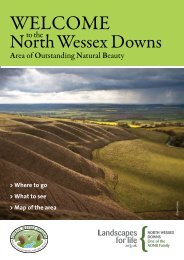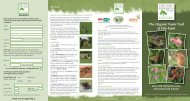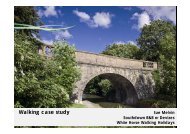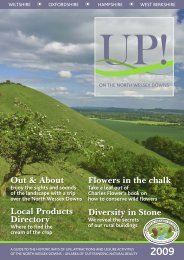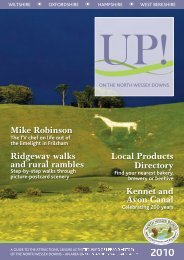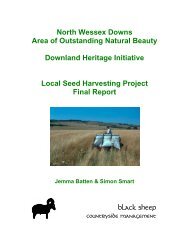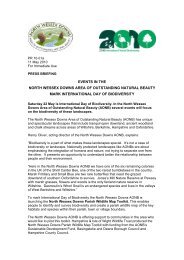A Study of Landscape Sensitivities and Constraints to Wind
A Study of Landscape Sensitivities and Constraints to Wind
A Study of Landscape Sensitivities and Constraints to Wind
- No tags were found...
You also want an ePaper? Increase the reach of your titles
YUMPU automatically turns print PDFs into web optimized ePapers that Google loves.
3.34. Detail on each <strong>of</strong> these typologies is noted in Table 3.4 below.Table 3.4: Definition <strong>of</strong> Turbine TypologiesHeight classHeight range(<strong>to</strong> blade tip)Number <strong>of</strong> turbinesTypical powerratingGridconnectionTypical associated infrastructureHeight Class 1 25 – 40m Single 10KW- 50KW Yes or No Battery unit or may require a small building <strong>to</strong>house inverter <strong>and</strong> controller if connected <strong>to</strong>the grid.Height Class 2 40 – 80m SingleSmall group (2-4)50KW – 800KW Yes Access tracks, control building/ substation,anemometerHeight Class 3 80 – 130m SingleSmall group (2-4)800KW +(e.g. up <strong>to</strong>current largestcommercialturbine <strong>of</strong>3MW)YesAccess tracks, powerlines, fencing, controlbuildings/sub station(s), anemometers3.35. It should be noted that the three turbine typologies are relative terms representing arbitrary divisions <strong>of</strong> a continuum; they havebeen developed simply as an aid <strong>to</strong> the evaluation <strong>and</strong> making <strong>of</strong> judgements. Visualising hypothetical height differences in thefield is complex. As such, each typology is represented by a nominal blade tip height (the tallest within the range) for the purpose<strong>of</strong> making judgements as <strong>to</strong> the effect <strong>of</strong> different heights <strong>of</strong> turbines on the l<strong>and</strong>scape. If a planning application is received on thethreshold <strong>of</strong> a type, for example for a turbine <strong>of</strong> 75m, it is recommended that the sensitivity analysis <strong>and</strong> judgements are reviewedfor both a Height Class 2 <strong>and</strong> Height 3 development.3.36. In addition <strong>to</strong> the turbines themselves, wind turbine developments may include a range <strong>of</strong> ancillary structures such as access tracks,power/pylon lines, sub stations, fencing, anemometers. Built structures such as sub stations maybe located on site or <strong>of</strong>f site. Thel<strong>and</strong>scape may also be sensitive <strong>to</strong> these additional structures. It was considered <strong>to</strong>o complex <strong>to</strong> attempt <strong>to</strong> define a range <strong>of</strong>typologies taking in<strong>to</strong> consideration different combinations <strong>of</strong> infrastructure <strong>and</strong> it would be virtually impossible <strong>to</strong> assess suchNorth Wessex Downs AONB: <strong>L<strong>and</strong>scape</strong> <strong>Sensitivities</strong> 24The Policy Framework, Current <strong>Wind</strong> Turbine Schemes<strong>and</strong> <strong>and</strong> <strong>Constraints</strong> <strong>to</strong> <strong>Wind</strong> Turbine Development Definition <strong>of</strong> Turbine Typologies




